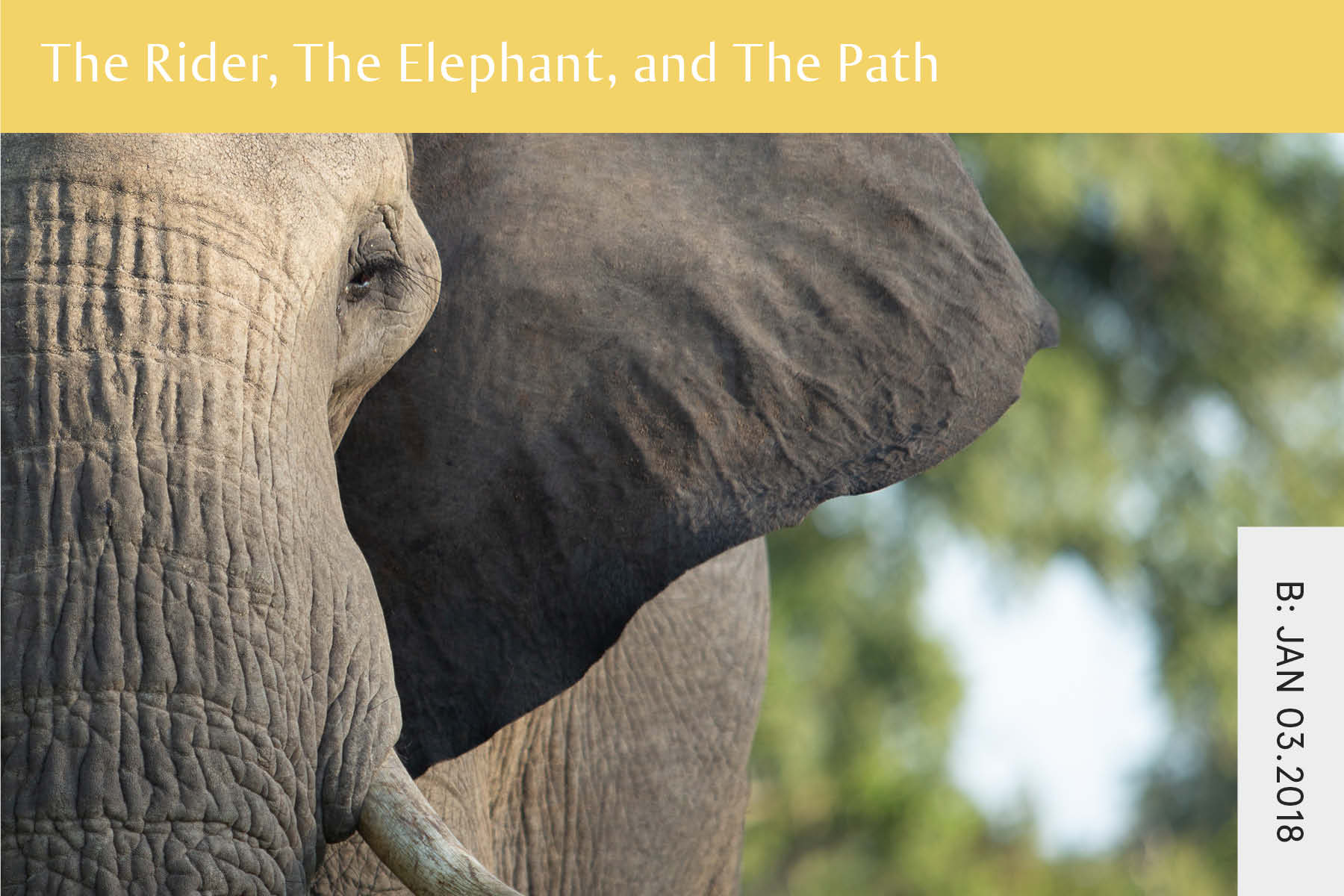

It’s that time of year again, the time of “new year, new you!” The time when people make big plans to change their life…and invariably change very little.
This lack of change is often blamed on willpower or some inherent character default, but neither of these are necessarily true.
I want to share an analogy that’s useful for conceptualising how we make decisions and make lasting change. I become aware of it from the work of Dan and Chip Heath (it was in their book Switch), but the originator of the analogy is Jonathan Haidt. It is the rider, the elephant, and the path.
The rider is your rational brain. It loves to contemplate the future (but more often focuses on the problems, rather than solutions); it looks for patterns and analyses options; and it makes plans (but gets frustrated by uncertainty). Ultimately, the rider is about logic and reason.
The elephant is your emotional brain, characterised by regions like the amygdala, which deals with fear (as well as other emotions) and the stress response. The elephant is easily spooked. It doesn’t like doing things that don’t provide immediate gratification, so it seeks pleasure and wants to avoid pain. It needs reassurance and is rapidly overwhelmed or demoralised.
The rider sits on top of the elephant. And while the rider holds the reins and seems to be the leader and navigator, it’s much more precarious that this. A human is no match for a 6-ton elephant, so when the rider and the elephant disagree about which direction to go, the rider is going to lose.
It could easily be misconstrued that the rider is “good” and the elephant is “bad”. That we need to suppress emotions. But this isn’t true.
These emotions are what provide us with energy, drive, ambition, and desire. They are what provide the power for the journey.
So rather than trying to silence emotions so that the rational brain can do all the work, instead we want the rider and elephant to collaborate. We want them to converge in their desire for the same thing, rather than struggling against one another.
The final part of this analogy is the path, and this represents our environment. The environment that we find ourselves in impacts us both consciously and unconsciously. We typically follow the path of least resistance and are nudged in the direction of convenience.
So even if the rider and elephant are on the same page and have the same end goal in mind, their success can easily be thwarted by an incompatible environment.
This means that when you want to make a change, you need to address all three areas.
The logical brain can get caught spinning its wheels. Constantly searching for more information and trying to figure out the absolute best way to do something. The solution is to figure out where you want to end up and just get started.
And while it can be helpful initially to think big picture, this now needs to be reduced down to specific behaviours. Nearly every success is a collection of small habits repeated consistently. So identify what these habits are so you know where to direct your attention.
Often the best place to start is by finding the bright spots. What this means is finding the things that are currently working and do more of it. Build on your current successes rather than trying to start from scratch.
The elephant isn’t interested in facts and reasons, it is all about emotions. Really feel why this change is important for you and understand it emotionally, not just intellectually.
And just like going from big picture to specific behaviors when directing the rider, you want to do something similar with the elephant.. You want to break the change down so it seems doable and doesn’t emotionally overwhelm the elephant.
But you also want to have it broken down so there are many small wins. That emotional high on day one is going to disappear. But if you can be constantly achieving regular mini goals, this keeps up the positive emotions.
I’ve done podcasts (here and here) and written this article on how seemingly insignificant changes in the environment can have a large impact on eating behaviour. And this is because the environment you find yourself in (or explicitly create for yourself) actually affects the thoughts and feelings you have.
Change is slow (often painfully so) and doesn’t match up to the emotional high we get from watching some 5-minute motivational clip of how someone turned their life around. But if you can think of change in terms of the rider, the elephant and the path, it will give you the best shot of getting there.
I’m a leading expert and advocate for full recovery. I’ve been working with clients for over 15 years and understand what needs to happen to recover.
I truly believe that you can reach a place where the eating disorder is a thing of the past and I want to help you get there. If you want to fully recover and drastically increase the quality of your life, I’d love to help.
Want to get a FREE online course created specifically for those wanting full recovery? Discover the first 5 steps to take in your eating disorder recovery. This course shows you how to take action and the exact step-by-step process. To get instant access, click the button below.
Discover the first five steps to take in your eating disorder recovery.
Get started the right way and be on the path to full recovery and the freedom it will bring YOU.
Unlike other approaches focusing on just one aspect of recovery, this course shares a framework that demonstrates what full recovery is really about and gives you the tools to get there.
Get Instant Access!
[…] by the “Elephant, Path, Rider” framework by psychologist Jonathan Haidt, an examination of the journey of using DFS for the […]